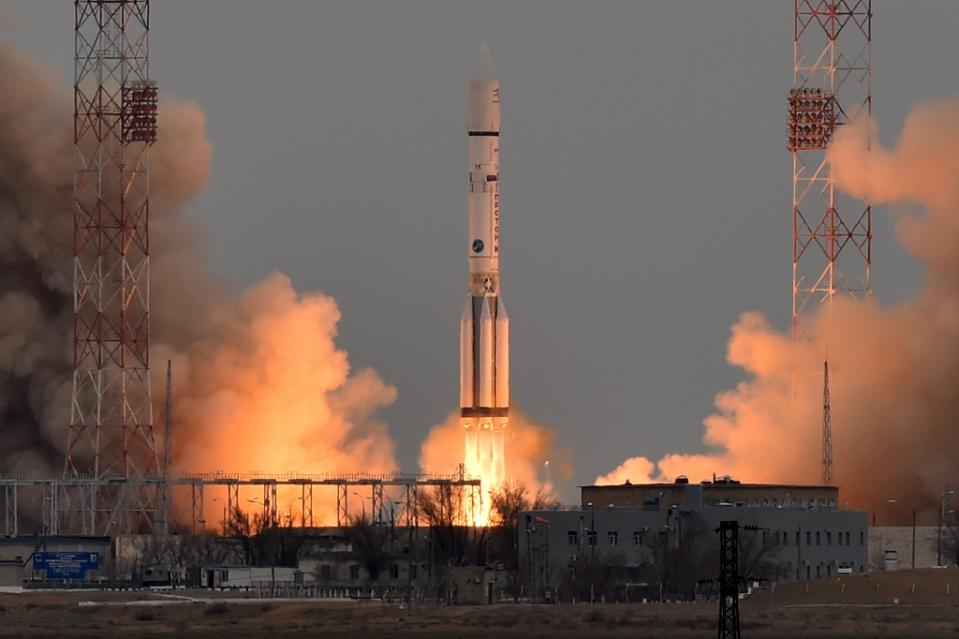
A Proton rocket carrying the ExoMars 2016 spacecraft blasts off from the Baikonur cosmodrome in Kazakhstan, on March 14, 2016 (AFP Photo/Kirill Kudryavtsev)
Europe and Russia launched a spacecraft in a joint mission in the hunt for life on Mars blasted off on Monday for the start of a seven-month unmanned space journey to the Red Planet.
The heavy-lift Russian rocket, part of the ExoMars program, blasted off from the Baikonur spaceport in Kazakhstan on board a Proton rocket at 5:31 A.M. EDT (0931 GMT) on Monday.
A Proton rocket carrying the Trace Gas Orbiter to examine Mars’s atmosphere and a descent module that will conduct a test landing on its surface launched into an overcast sky at the Russian-operated Baikonur cosmodrome in the Kazakh steppe at 0931 GMT.
The first of two ExoMars missions to be launched together cost 1.2 billion euro. The ExoMars 2016 mission, a collaboration between the European Space Agency (ESA) and its Russian equivalent Roscosmos, is the first part of a two-phase exploration are designed to uncover signs of past or present life on the Red Planet.
The spacecraft is set to detach from its Briz-M rocket booster just after 2000 GMT before beginning its 496-million-kilometre (308-million-mile) voyage through the cosmos.
The Trace Gas Orbiter will hunt for methane in the Martian atmosphere and show if it is likely to have been generated by geology or biological processes. A lander dubbed Schiaparelli will detach and descend to the surface of the fourth planet from the Sun.
The landing of the module on Mars is designed as a trial run ahead of the second stage of the mission scheduled in 2018 that will see the first European rover landed on the surface to drill for signs of life, although problems with financing mean it could be delayed.
ESA director general Jan Woerner has put forward a possible two-year delay, saying in January: “We need some more money” due to cost increases.
One key goal of the Trace Gas Orbiter is to analyse methane, a gas which on Earth is created in large part by living microbes, and traces of which were observed by previous Mars missions.
“TGO will be like a big nose in space,” said Jorge Vago, ExoMars project scientist.
Methane, the ESA said, is normally destroyed by ultraviolet radiation within a few hundred years, which implied that in Mars’ case “it must still be produced today”.
TGO will analyse Mars’ methane in more detail than any previous mission, said ESA, in order to try to determine its likely origin.
One component of TGO, a neuron detector called FREND, can help provide improved mapping of potential water resources on Mars, amid growing evidence the planet once had as much if more water than earth.
A better understanding of water on Mars could help scientists fathom how the Earth might deal with conditions of increased drought.
Schiaparelli, in turn, will spend several days measuring climatic conditions including seasonal dust storms on Earth’s neighbor while serving as a test lander ahead of the rover’s anticipated arrival.
The module takes its name from 19th century Italian astronomer Giovanni Schiaparelli whose discovery of “canals” on Mars caused people to believe, for a while, that there was intelligent life on the red planet.
Both ExoMars spacecraft were built and designed by Franco-Italian contractor Thales Alenia Space.
The ExoMars mission will complement the work of NASA’s ‘Curiosity’ rover which has spent more than three years on Mars as part of the Mars Science Laboratory (MSL) mission.
Curiosity, a car-sized mobile laboratory, aims to collect soil and rock samples on Mars and analyze them “for organic compounds and environmental conditions that could have supported life now or in the past,” according to NASA.
Space has been one of the few areas of cooperation between Moscow and the West that has not been impaired by unending geopolitical tensions stemming from to the crises in Ukraine and Syria.
